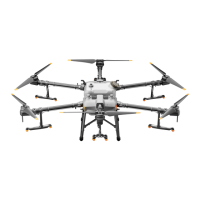4. DO NOT drop, launch, fire, or otherwise project any dangerous payloads on or at any buildings, persons, or
animals, or which could cause personal injury or property damage.
Notice
1. Make sure you have been sufficiently trained and have contingency plans for emergency situations or for when
accidents occur.
2. Make sure you have a flight plan and DO NOT fly the aircraft recklessly.
3. DO NOT use this product for any illegal or inappropriate purpose such as spying, military operations, or
unauthorized investigations.
4. DO NOT use this product to defame, abuse, harass, stalk, threaten, or otherwise violate the legal rights of
others, such as the right of privacy and publicity.
5. DO NOT trespass onto private property of others.
Flight Modes, Operation Modes, Functions, and Warnings
Flight Modes
P-mode (Positioning): The aircraft utilizes GNSS or the RTK module for positioning. When the GNSS signal is
strong, the aircraft uses GNSS for positioning. When the RTK module is enabled and the differential data
transmission is strong, it provides centimeter-level positioning. It will revert to A-mode when the GNSS signal is
weak or when the compass experiences interference. The aircraft will fly in P-mode by default. A-mode (Attitude):
GNSS is not used for positioning and the aircraft can only maintain altitude using the barometer. The flight speed
in A-mode depends on its surroundings such as the wind speed. In A-mode, the aircraft cannot position itself and
is easily affected by its surroundings, which may result in horizontal shifting. Use the remote controller to position
the aircraft. Maneuvering the aircraft in A-mode can be difficult. Avoid flying in confined spaces or in areas where
the GNSS signal is weak. Otherwise, the aircraft will enter A-mode, leading to potential flight risks. Land the
aircraft in a safe place as soon as possible.
Operation Modes
Warning
To avoid component malfunction, serious injury, and property damage, observe the following rules:
1. Make sure that you fully understand the aircraft’s behavior under each operation mode before use.
2. Stay clear of obstacles near the operation route. Maintain line of sight to the aircraft and observe its status at all
times.
3. Only operate in Route or A-B Route Operation mode when receiving a strong GNSS signal.
Failsafe and Return to Home (RTH)
Notice
1. RTH will not work if there is a weak or no GNSS signal.
2. Tall buildings may adversely affect RTH. Therefore, it is important to set an appropriate failsafe altitude before

